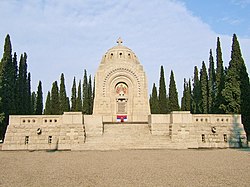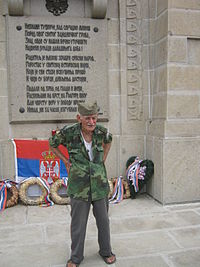
Serbian Chapel at Zeitenlik
Zeitenlik (Greek: Ζέιτενλικ, Serbian Cyrillic language: Зејтинлик ) is an Allied military cemetery in Thessaloniki, Greece. It contains the graves mostly of the Serbian (more than 7000) but also of French, English and Russian soldiers who died in the battles on the Salonika front during World War I. The complex is located on the place where the Main Hospital of the Serbian Army was located during the war.
The name comes from the Turkish word Zeytin which means Olive. It can be translated as Olive plantation.[1] It is located on Lagkada street, about 1.5 km from the city centre.[1]
History[]

French Monument at Zeitenlik

Zeitenlik view
The agreement establishing the Allied cemeteries was signed on November 20, 1920, by the Greek Governor-General of Thessaloniki Anastasios Adossides and the allies Vojvoda Živojin Mišić (Serbia), General Jean Noël Boucher (France), Field Marshal George Francis Milne (England) and Colonel Curgio Giamberini (Italy). The Greek government bought the land where the cemetery would be created and ceded it to the allies in usufruct, while maintenance of the cemeteries was left to their governments.
The project began in 1926, when Savo Mihailović was appointed to head the group that was tasked to collect the remains of warriors scattered across a wide area where the battle raged on the Salonika front. They visited over 250 cemeteries to find allied soldier graves and move them to the new cemetery space.
The conceptual design of the Serbian military cemetery was selected that same year at a contest, and the design of the architect Aleksandar Vasić, whose idea was further elaborated by Nikolaj Krasnov, was chosen. All materials for the construction of the cemetery came from Serbia, where it was also first processed. Therefore, the preparations for the start of construction lasted until 1933 because of the need to prepare large quantities of trimmed stone for the construction of the mausoleum, chapel and charnel house, and about 2000 marble crosses.
Finishing works began in 1933 under the direction of architect Budimir Hristodulo, one of the 1300 corporals. It was brought to an end at the end of 1936, and on 11 November 1936, on Armistice Day in World War I, the mausoleum, chapel and crypt were officially sanctified. Greece gave free land to build a complex of 7,000 km², and all material and work on the cemetery was released from customs and exempted from tax.
Stone from the Momin kamen quarry, which is located near the village of Džep in Serbia was used for building the mausoleum and crosses, granite from Kadina Luka near Ljig was used for the slabs, and the cement was from Beočin. Cypress trees that were delivered as young seedlings from Hilandar were planted around the Serbian part of the cemetery. The mosaic in the chapel which incorporates motifs from medieval Serbian frescoes is the work of the Greek artist Voila.
During World War II, the burden of preserving the cemetery fell onto the guard Đuro Mihailović. In spite of the war, the teen managed to preserve the cemetery and prevent Nazi looting of books and relics.
Thanks to the efforts of the Secretariat for the Culture of Serbia funds for the restoration of the cemetery were collected. Works were carried out from 25 September to 22 October 1969, and apart from the renovation of the vast complex, a sidewalk was built in front of the entrance to the cemetery, and an iron inscription saying "Serbian military cemetery" was placed on the front gate.
Cemetery keepers - the Mihailović family[]

Đorđe Mihailović in front of the cenotaph.
The first keeper of the graveyard was Savo Mihailović who was the head of the group that was responsible for the exhumation of Serbian soldiers and their transfer to the area of the future military cemetery. Mihailović, a Serb from Grbalj, collected the bodies of his dead friends and comrades, and then protected and guarded the cemetery until his death in 1928. He lived in a house built for him and his family, inside the cemetery proper. After his death, his remains were also buried in Zeitenlik. He was succeeded by his son Đuro Mihailović, who succeeded in preserving the cemetery and relics from Nazi looting during World War II. Đuro died in 1961 and was buried along with his father on Zeitenlik.
Today, the keeper, host and curator of the Serbian Military Cemetery at Zeitenlik is Đorđe Mihailović, Đuro's son and Savo's grandson, who lives in the keepers house with his wife and daughter.
References[]
See also[]
| Wikimedia Commons has media related to Memorial park of Zeitenlik, Thessaloniki. |
Coordinates: 40°39′16″N 22°56′01″E / 40.654441°N 22.933713°E
The original article can be found at Zeitenlik and the edit history here.